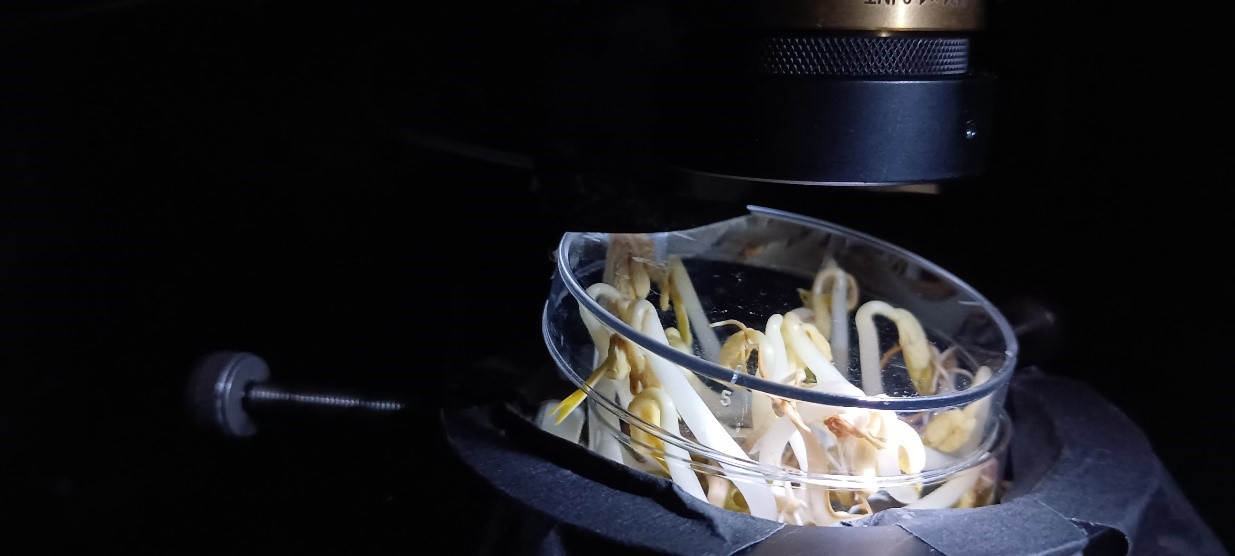Light and life have gone hand in hand for millions of years. Plants rely on the sun to produce energy, while many members of the animal kingdom rely on light to see and understand their surroundings. Humans use light to transfer information and communicate across the globe. But did you know the cells that make up our bodies may also be talking to each other using light?
In the 1920s, Alexander G Gurwitsch placed two onion roots next to each other in sealed containers for an incredible result. He observed more mitosis – that is, cells dividing to make new ones – on the roots that faced one another, suggesting they were somehow influencing each other even when no chemicals could physically interact. Gurwitsch had discovered a phenomenon known as ultra-weak photon emission, or UPE. The cells that make up living organisms can emit very faint amounts of light, which is potentially a method of communication between them.
Scientists from the CLF’s Octopus facility and the University of Westminster set out to explore how we can study this light, and what external factors might influence the signals. But this is no easy experiment - the first difficulty arises in how faint the emitted light is. While cells may be able to easily ‘see’ and react to tiny light changes, our outside world is extremely bright. The team therefore constructed a set-up that relies on a super-sensitive detector system called photomultiplier tubes (PMT). In simple terms, PMTs produce high amounts of current when even just one photon (particle of light) is detected, which allows scientists to pick up a big signal from the smallest amounts of light. This is ideal for detecting UPE, but on the other hand it becomes even harder to ignore any light that may be unwanted. Windows, lightbulbs, and even light from instruments can overshadow and impact results. Therefore, both the cells and the detectors must be placed inside a light-tight container, with the surrounding rooms and even the neighbouring rooms in complete darkness!
The group then needed to pick an organism suitable for this type of study. The answer was found in the mung bean – a plant able to grow in complete darkness, only requiring the addition of water. Light emission is thought to predominantly come from two key areas of the plant cell; one of which is the chloroplasts, where photosynthesis occurs. However, it has been found that UPE is strongly linked to metabolism and stress responses, which are controlled in the mitochondria. This is the connection on which the team based their investigation.

Image credit: A. M. Mackenzie, Central Laser Facility
They firstly noted that more mature, larger plants recorded higher amounts of UPE that their younger counterparts, likely due to the higher numbers of cells capable of such emission. Additional spikes in UPE were recorded during drought, and immediately after watering following this experience. There is therefore an implication that light emission may be a result of the plant’s stress response.
The group also detected peaks in light emission in times of growth, strongly detected from the roots rather than above ground. They found that these spikes were associated specifically with secondary root growth. To test this further, they repeated the experiment with additional growth hormones such as hydrogen peroxide and auxin, which showed both increased secondary root formation and further UPE – more evidence that the two processes are connected.
But why do the mung beans, and other plants, emit more light when growing their roots, or under stress? It could be allowing the cells to instruct and listen to one another to increase the chances of the collective plant’s survival. For instance, it may tell roots to grow away from one another to reach more resources in soil. Root cells may be able to tell one another if they are experiencing drought, prompting others to find water. If a root comes across something toxic, it could tell others to stay away.
The CLF and the University of Westminster’s mung bean experiment was highly successful, picking up clear UPE emissions through their sensitive system of detection. In doing this, they have collected valuable data on the relationship between plant growth and light emission from their cells, and how external factors may influence this - bringing science ever closer to learning the language of cells.
Original Publication:
Alasdair M. Mackenzie, Holly E. Smith, Rhys R. Mould, Jimmy D. Bell, Alistair V.W. Nunn, Stanley W. Botchway (2024), Rooting out ultraweak photon emission a-mung bean sprouts, Journal of Photochemistry and Photobiology, 19, 100224.
https://doi.org/10.1016/j.jpap.2023.100224
